|
Description |
Text |
Tags |
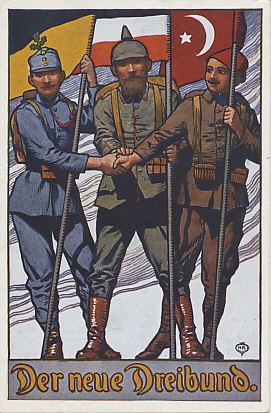 more more |
The new Dreibund, or Triple Alliance, of Austria-Hungary, Germany, and Turkey. The original Triple Alliance included Italy rather than Turkey, but Italy declared neutrality on August 3, 1914, then war on Austria-Hungary on May 24, 1915. The Austro-Hungarian soldier on the left is holding the Hapsburg flag. Illustration by HR. |
Der neue Dreibund.
The new Triple Alliance.
Logo:
HR
Reverse:
Message dated and field postmarked November 17, 1915. |
Dreibund, Central Powers, 1915-01-18, 1914, 1915 |
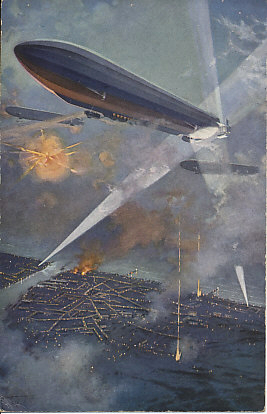 more more |
Zeppelins over the English coast. Zeppelins first raided England on January 19, 1915. |
Zeppeline über der englischen Küste
Zeppelins over the English Coast
Reverse:
Message dated May 25, 1915, and field postmarked May 27.
Logo: GMT |
English coast, Zeppelin, Zeppelin raid, 1915, January, 1915-01-19 |
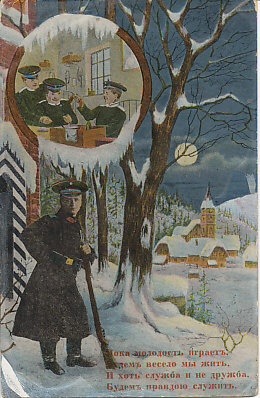 more more |
A Russian soldier standing guard on a moonlit winter night reflects on his youthful fun and friendships. A Russian postcard with a message from a German soldier to his sister dated March 28, 1915. |
Reverse:
Field postmarked message dated March 28, 1915 from a brother to his sister, thanking her for the cake she sent. |
Imperial Russian Soldier, Russian soldier, winter watch, 1915 |
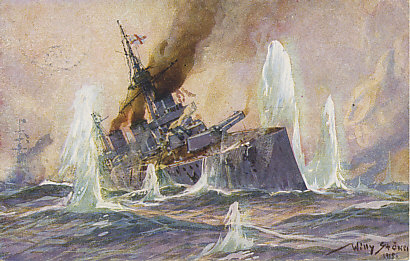 more more |
An English battle cruiser under fire in the Battle of Dogger Bank, January 24, 1915. From a painting by Willy Stöwer. |
Willy Stöwer 1915
Reverse:
Kolonialkriegerdank
Eingetrag. Verein zur Unterstüzung ehemaliger Kolonialkrieger der Armee, Marine, der Schutz-, und Polizeitruppen sowie deren Hinterbliebenen
Berlin W 35, Potsdamer Str. 98a
Schutzherr: Herzog Johann Albrecht zu Mecklenburg Ehrenpräsid.; Herzog Adolf Friedrich zu Mecklenburg Frhr. v. Gaul, General d. Inf., Mital. d. Herrenhauseß
Aus dem Seegefecht in der Nordsee am 24. Jan. 1915. Englischer Schlachtkreuzer im Salvenfeuer deutscher Kreuzer. Nach einem Original von Prof. Willy Stöwer.
No. 10.
Colonial Warrior Thanks
Registered association for technology to support the former colonial warriors of the Army, Navy, protection troops, and police forces and their dependents
Berlin W 35, Potsdamer Str. 98a
Patron: the Duke Johann Albrecht of Mecklenburg Honorary President; Duke Adolf Friedrich of Mecklenburg Baron. von. Gaul, Infantry General, Fellow-elder of the Prussian House of Lords
From the naval battle in the North Sea on January 24, 1915. An English battle cruiser under a salvo from a German cruiser. From an original by Prof. Willy Stöwer.
No. 10 |
Stöwer, Battle of Dogger Bank, 1915, January, 1915-01-24, battle, cruiser, Dogger Bank |
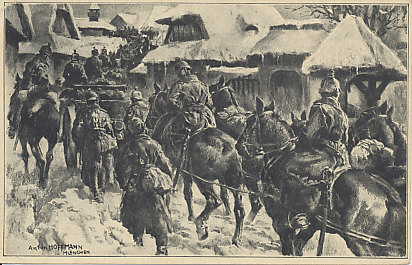 more more |
German artillery moving through a village in the Carpathian mountains. From a drawing by Anton Hoffmann. |
Anton Hoffmann - Muenchen
Anton Hoffman - Munich
Reverse:
Kriegsbilder aus Reclams Universum
Deutsche Artillerie in den Karpathen. Nach einer Zeichnung von Prof. Anton Hoffmann.
Verlag von Philipp Reclam jun. Leipzig
War images from Reclams universe
German Artillery in the Carpathians. After a drawing by Prof. Anton Hoffmann.
Publisher Philipp Reclam, junior, Leipzig
Message dated January 12, 1916 |
Anton Hoffmann, Hoffmann, artillery, Carpathians, 1915, winter, Carpathian Mountains, field artillery, field gun, horse, horses |

